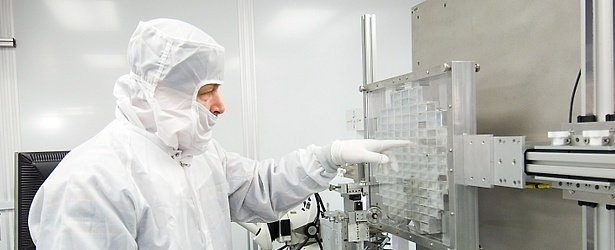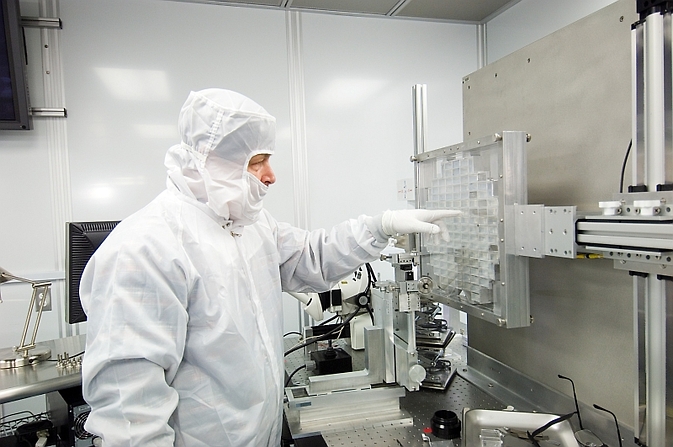Stardust’s payload holds first potential interstellar space particles

A team of scientists has been combing through the payload of NASA's Stardust spacecraft since it returned to Earth in 2006. They found seven rare, microscopic interstellar dust particles, that most likely came from outside of our solar system.
If confirmed, these particles would be the first samples of contemporary interstellar dust. Scientists caution that additional tests must be done before they can say definitively that these are pieces of debris from interstellar space. But if they are, the particles could help explain the origin and evolution of interstellar dust.
The research report appears in the August 15 issue of the journal Science. Twelve other papers about the particles will appear next week in the journal Meteoritics & Planetary Science.
Michael Zolensky, co-author of the Science paper and curator of the Stardust laboratory at NASA’s Johnson Space Center in Houston, said that those are the most challenging objects they will ever have in their lab for study. "It is a triumph that we have made as much progress in their analysis as we have."
The particles are much more diverse in terms of chemical composition and structure than scientists expected. The smaller particles differ greatly from the larger ones and appear to have varying histories. Many of the larger particles have been described as having a fluffy structure, similar to a snowflake.
Two particles, each only about two microns (thousandths of a millimeter) in diameter, were isolated after their tracks were discovered by a group of citizen scientists. These volunteers, who call themselves "Dusters," scanned more than a million images as part of a University of California, Berkeley, citizen-science project, which proved critical to finding these needles in a haystack.
A third track, following the direction of the wind during flight, was left by a particle that apparently was moving so fast — more than 10 miles per second (15 kilometers per second) — that it vaporized. Volunteers identified tracks left by another 29 particles that were determined to have been kicked out of the spacecraft into the collectors.

The largest interstellar dust track found in the Stardust aerogel collectors was this 35 micron-long hole produced by a 3 picogram mote that was probably traveling so fast that it vaporized upon impact. The other two likely interstellar dust grains were traveling more slowly and remained intact after a soft landing in the aerogel. Image credit: Andrew Westphal, UC Berkeley
Four of the particles reported in Science were found in aluminum foils between tiles on the collector tray. Although the foils were not originally planned as dust collection surfaces, an international team led by physicist Rhonda Stroud of the Naval Research Laboratory searched the foils and identified four pits lined with material composed of elements that fit the profile of interstellar dust particles.
Three of these four particles, just a few tenths of a micron across, contained sulfur compounds, which some astronomers have argued do not occur in interstellar dust. A preliminary examination team plans to continue analysis of the remaining 95 percent of the foils to possibly find enough particles to understand the variety and origins of interstellar dust.
Supernovas, red giants and other evolved stars produce interstellar dust and generate heavy elements like carbon, nitrogen and oxygen necessary for life. Two particles, dubbed Orion and Hylabrook, will undergo further tests to determine their oxygen isotope quantities, which could provide even stronger evidence for their extrasolar origin.
Scientists at Johnson have scanned half the panels at various depths and turned these scans into movies, which were then posted online, where the Dusters could access the footage to search for particle tracks.
Once several Dusters tag a likely track, Andrew Westphal, lead author of the Science article, and his team verify the identifications. In the one million frames scanned so far, each a half-millimeter square, Dusters have found 69 tracks, while Westphal has found two. Thirty-one of these were extracted along with surrounding aerogel by scientists at Johnson and shipped to UC Berkeley to be analyzed.
- Stardust mission on the Web: www.nasa.gov/stardust
Featured image credit: Andrew Westphal, UC Berkeley

Commenting rules and guidelines
We value the thoughts and opinions of our readers and welcome healthy discussions on our website. In order to maintain a respectful and positive community, we ask that all commenters follow these rules:
We reserve the right to remove any comments that violate these rules. By commenting on our website, you agree to abide by these guidelines. Thank you for helping to create a positive and welcoming environment for all.